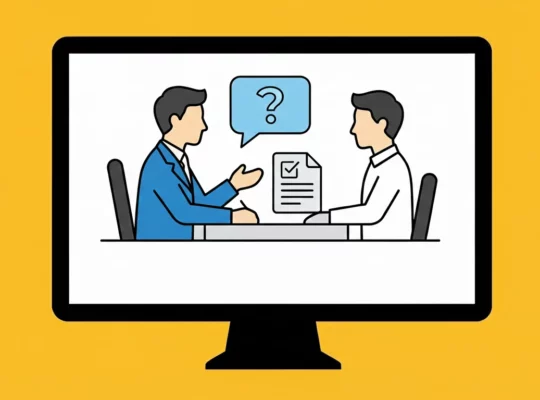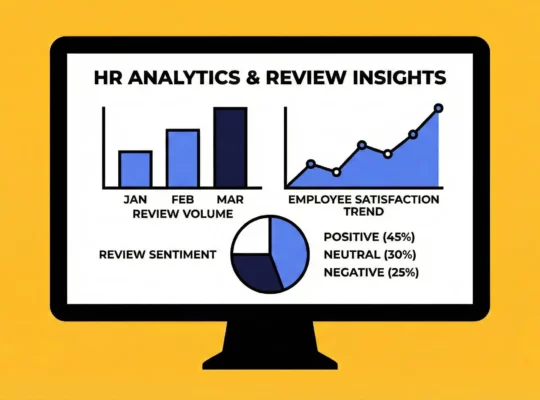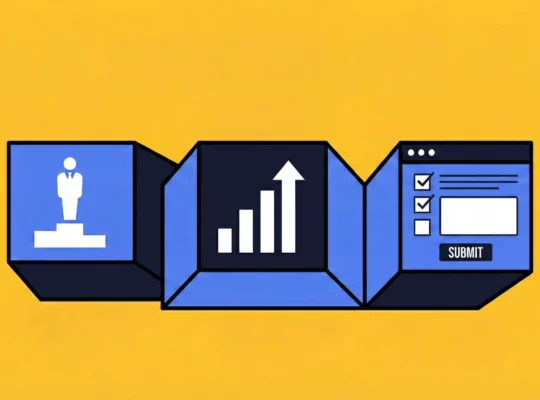Imagine you’re driving and accidentally veer off the road. A correction might be steering back onto the road. However, a corrective action would be inspecting your tires, brakes, and alignment to prevent future accidents. In employee management, these two approaches are equally important, but they serve different purposes.
Table of Contents
What is Correction?
What is Corrective Action?
Streamlining Corrective Actions: A 3-Step Guide
The Key Differences Between Correction and Corrective Action
When to Use Correction vs. Corrective Action in Employee Management
The Role of Managers in Implementing Corrective Action
Benefits of Understanding and Applying Both Approaches
How Review.jobs Empowers Smart Corrections
What is Correction?
Correction refers to the immediate action taken to address a detected problem. This reactive approach focuses on fixing the symptoms of the issue without delving into the root cause. While corrections can be effective for resolving immediate concerns, they often don’t prevent the problem from recurring.
For example, if a manager notices an employee frequently arriving late, a correction might be simply reminding them of the start time. This solution addresses the immediate issue—tardiness—but does not explore why the employee is late, whether it’s due to transportation challenges, scheduling conflicts, or other underlying issues. In this case, the correction is a surface-level solution.
Common examples of corrections in the workplace include:
- Resetting an employee’s login credentials after repeated lockouts.
- Reassigning a task to another team member when the original person is overloaded.
- Offering short-term training to address a single performance gap.
These actions can solve problems in the short term, but without examining the underlying causes, the same issues may return, resulting in inefficiencies over time.
What is Corrective Action?
Corrective action, on the other hand, takes a deeper dive into problem-solving by addressing the root cause of an issue to prevent it from happening again. This systematic approach involves investigating the problem, analyzing trends, and monitoring data to create lasting solutions.
A corrective action is not just about treating the symptom; it focuses on eliminating the source of the problem. In the earlier example of employee tardiness, a corrective action might involve investigating patterns of lateness, conducting employee feedback surveys, and addressing external factors such as transportation or work-life balance. This could lead to implementing flexible work hours or providing transportation benefits.
Streamlining Corrective Actions: A 3-Step Guide
Step 1: Dive Deep to Find the Root Cause
- Don’t Just Scratch the Surface: Dig beneath the symptoms to uncover the underlying cause of the problem. This is the key to implementing effective corrective actions.
- Root Cause Analysis Tools: Utilize tools like fishbone diagrams or 5 Whys to trace the problem back to its source.
Step 2: Craft a Targeted Action Plan
- Clear Objectives: Define specific, measurable, achievable, relevant, and time-bound (SMART) goals for your corrective actions.
- Assign Responsibility: Assign roles and responsibilities to ensure accountability and effective implementation.
- Allocate Resources: Provide the necessary resources, including time, budget, and support, to carry out the action plan.
Step 3: Prevent Recurrence
- Proactive Measures: Implement preventive actions to address the root cause and prevent similar issues from arising in the future.
- Regular Monitoring: Continuously monitor and evaluate the effectiveness of your corrective actions.
- Adjust as Needed: Be prepared to make adjustments to your action plan based on feedback and changing circumstances.
The Key Differences Between Correction and Corrective Action
Though both correction and corrective action are important in problem-solving, they serve different purposes in employee and process management.
| Feature | Correction | Corrective Action |
| Purpose | Addresses immediate issues | Prevents future recurrence |
| Scope | Isolated incidents | Systemic problems |
| Timeframe | Immediate | Long-term |
| Focus | Temporary relief | Prevention |
| Application | Urgent client issues, minor problems | Systemic issues, recurring problems |
When to Use Correction vs. Corrective Action in Employee Management
Understanding when to apply correction versus corrective action is crucial for maintaining a healthy and productive workplace.
Correction Scenarios
- Addressing one-off issues, such as a single performance slip-up.
- Resolving urgent client concerns where time is critical.
- Fixing minor, isolated incidents that don’t indicate a larger trend.
Corrective Action Scenarios
- Ongoing issues like recurring quality control failures, indicate a deeper problem in the process.
- Compliance concerns, such as repeated failures to meet ISO standards or food safety regulations.
- Systemic employee issues, like high turnover rates or consistent underperformance across a team.
The Role of Managers in Implementing Corrective Action
One of the most important responsibilities of managers is recognizing when a problem requires corrective action rather than just a quick correction. Effective management includes encouraging a culture of continuous performance improvement, where employees are empowered to address issues at their core.
Root Cause Analysis
A key tool for managers is root cause analysis, which digs beneath the surface of problems to discover their origins. Whether it’s recurring workplace accidents, quality control issues, or employee dissatisfaction, a root cause analysis helps managers implement long-lasting solutions.
Tools and Techniques
There are several strategies for implementing corrective action:
- Process mapping: Managers can use process mapping to identify inefficiencies or areas prone to errors.
- Employee feedback mechanisms: Anonymous reviews or open feedback sessions allow employees to share insights into workplace challenges.
Benefits of Understanding and Applying Both Approaches
Balancing correction with corrective action provides businesses with immediate and long-term benefits. While correction satisfies urgent needs and boosts short-term satisfaction, corrective actions offer sustainable improvements and a pathway to continuous growth.
Immediate Benefits
- Increased customer and employee satisfaction through fast corrections.
- Avoiding disruptions in day-to-day operations by quickly resolving minor issues.
Long-term Benefits
- Reduced recurrence of problems due to addressing root causes.
- Enhanced operational efficiency by creating a culture of continuous improvement.
- Fewer compliance issues by aligning actions with ISO standards or other regulatory requirements.
By implementing both approaches, companies can achieve a well-rounded management system that promotes quality control and improves employee satisfaction.
How Review.jobs Empowers Smart Corrections
Employee feedback isn’t just about hearing opinions – it’s about sparking positive change. Review.jobs goes beyond collecting responses; it’s a platform that turns feedback into action.
Let’s explore how Review.jobs empowers you to:
1. Identify & Address Recurring Issues:
- Catch Problems Early: Uncover hidden patterns and systemic issues employees face.
- Proactive Response: Turn concerns into action plans, preventing future problems.
Example: Multiple reviews mention dissatisfaction with food safety procedures. This triggers a root cause analysis to identify and fix the core issue.
2. Develop Targeted Action Plans:
- Data-Driven Solutions: Use feedback to refine management processes and prevent similar issues.
- Customizable Actions: Tailor corrective actions to address specific needs, like enhancing safety protocols based on employee concerns.
Example: Employee feedback highlights concerns with workplace safety. This data helps improve safety management systems, ensuring targeted corrective and preventive actions.
3. Foster Continuous Improvement:
- Feedback Loop for Growth: Identify problems, implement solutions, and track their effectiveness.
- Data-Driven Decisions: Use ongoing feedback to adjust and refine your corrective actions.
Example: Feedback about workload is addressed through adjustments in workload distribution. Ongoing feedback helps verify if these changes are effective and prevent future issues.
4. Boost Employee Engagement:
- Show You Care: Demonstrate commitment to addressing employee concerns.
- Increased Satisfaction: Employees feel valued when their feedback leads to positive change.
Example: Reviews highlight team dynamics challenges. Your team uses this information to implement team-building activities, which leads to increased employee satisfaction.
5. Encourage Transparency & Accountability:
- Open Communication: Make employee feedback a cornerstone of your management system.
- Managerial Responsibility: Hold managers accountable for addressing feedback and driving long-term improvement.
Example: Review.jobs ensures managers take responsibility for implementing corrective actions, like improving ISO standard compliance.
6. Leverage Data-Driven Decisions:
- Smarter Management: Use employee feedback data to guide decision-making across the organization.
- Prioritized Actions: Identify areas requiring immediate attention and develop solutions to prevent future challenges.
Example: Data from Review.jobs helps prioritize areas within your quality management system that need the most improvement based on employee experience.
At Review.jobs, we empower companies with tools that allow them to manage employee feedback effectively and implement both corrective and preventive actions. By leveraging authentic employee reviews, businesses can gain insights into underlying workplace challenges and take proactive steps to enhance employee experience. Start your journey toward better employee management and operational success with Review.jobs today.





